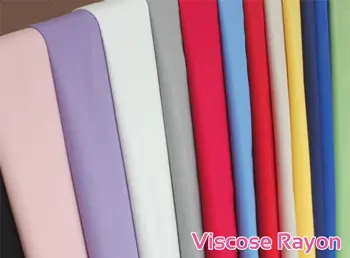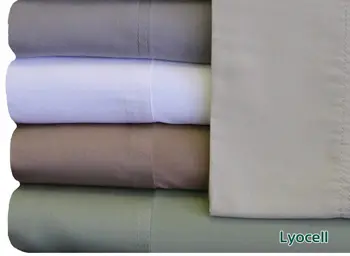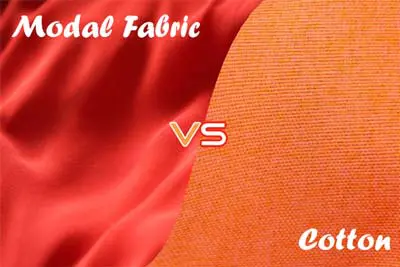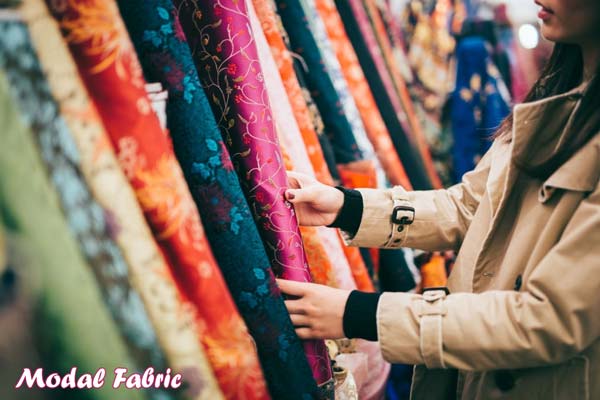What Is Modal Fabric: Detailed Discussion With Pros And Cons
Are you tired of getting sweaty inside under the scorching sun? Feeling uncomfortable to get anywhere near your loved one?
Say no to the discomfort with modal fabric!
Before getting into the discussion, what is modal fabric? You may ask.
This is a semi-synthetic fiber made of cellulose obtained from beech trees. You can think of it as another variation of the popular rayon fabric. Like cotton, it is also a very comfortable and breathable option for the summer.
Feel the softness against your skin every day with the modal fabric garments!
If you are unaware of what is modal fabric, how this fabric came to be, what it is really good for and how to take care of it - we got you covered! Keep reading below to know all about the modal fabric!
Table of Contents
History Of Modal Fabric
Like many popular fabrics of today, the modal fabric also has its roots in Japan. It was first developed there in 1951.
To industrialize this amazing fiber, it was then commercially developed by an Austrian company called Lenzing Fibers. This brand has been producing the majority of modal fabric since 1964.
After following the original method of production, Lenzing switched gears to improve the overall efficiency of their process in order to meet the huge customer demands. The company itself came up with a more environment-friendly method to bleach the wood pulp.
Being aware of the environmental impact and modifying it to ensure the long-lasting health of our planet has certainly brought them a lot of reliability. That is why now Lenzing Modal is a signature fabric with impressive customer demand around the globe.
How Modal Fabric Is Made?
The modal fabric production comes down to one phrase - “beech please”. That is because wood pulp from beech trees is the primary component of making this fabric.
Because of the involvement of chemicals, the modal fabric is categorized as a semi-synthetic fabric rather than a natural one. You may also classify it as a softer and more durable variation of rayon.
First of all, the cellulose is extracted from the wood pulp of harvested and chipped beech trees. This cellulose is reconstituted and then spun to prepare the material in modal sheets.
After that, it needs to be soaked in certain chemicals like carbon disulfate and sodium hydroxide. The latter is applicable to the cellulose sheets.
These are broken into smaller pieces and then submerged in carbon disulfate to prepare sodium cellulose xanthate.
This compound is again soaked in sodium hydroxide. The resulting liquid solution passes through a spinneret which finally creates the fibers.
Yarns are produced from these fibers by soaking them in sulfuric acid. Then the professionals knit or weave these yarns to create the fabric called modal.
How Modal Fabric Is Different From Other Fabrics?
Being a variation of rayon, the modal fabric exhibits quite a few similarities with similar fabrics like cotton, viscose and lyocell.
The differences between them are very subtle. Most of these dissimilarities are related to their structures and environmental impacts. Let’s discuss them in details now!
More Comfortable Than Cotton
While cotton is usually the most prominent choice for water-absorbent fabrics, modal can actually prove to be an even better option by offering even more absorption.
Because of this feature, you can feel more comfortable in the summer no matter how much sweat you have to deal with throughout the day.
Your body will stay drier in the modal fabric than in cotton. As a result, it will be a much more comfortable option for work, home and everything in between. The beechwood pulp structure allows more room to breathe in these garments as well.
>> Our Definitive Guide About Sewing Machine Working Process
Eco-friendlier Than Cotton
The modal fabric is a little eco-friendlier than cotton. The Lenzing modal is developed using sustainable methods that help to keep the environment safe. Besides, their methods lead to producing ten times more fiber than that of cotton.
As a result, the company can see more profit with modal while also helping mother earth.
Stronger and Lighter Than Viscose
Even though the production of both viscose and modal fabric follow similar processes, the latter turns out to be stronger than the other.
This is because the modal fabric fibers are processed differently once the spinning is done. So the filaments come out stronger than viscose.
Additionally, the fabric also becomes lighter and finer since its stretched texture has increased molecular alignments. This makes it easier for the wearer to tumble dry the modal fabric compared to viscose.
Soft Like Wool Minus The Hoarse Texture
The feeling of a modal fabric against your skin will be similar to that of wool or silk. However, you will not feel like scratching that covered area which is a constant problem for many wool-lovers.
So enjoy the soft and smooth material of modal fabric complementing your similar velvety skin!
Types Of Modal Fabric
Viscose Rayon

Viscose Rayon was the first form of modal fabric to reach customers worldwide. Besides, its affordable cost made it an easy choice for mass production.
The simple formula along with the reasonable expense made viscose rayon popular among the garment industrialists.
Although the formula is simple, the process to implement it to get viscose rayon fabric is quite complicated.
There are a number of chemicals involved in this multi-layered method. Besides, it has a moderately adverse impact on the environment as well as the workers.
You will often see this fabric in comfortable outerwear like shirts, jackets, coats, dresses and shorts. Viscose rayon is a popular choice in these categories since it provides a silky feeling without the high price tag. It is also popular for using in linings.
Other than wearable garments, the fabric of viscose rayon is used in household furnishing objects like carpets and upholstery. In the case of other industrial uses, viscose rayon can be found in tire cords, disposable wipes and cellophane casting.
Lyocell

You can think of lyocell as an updated version of viscose rayon. This modern modal fabric is an organic alternative to the traditional rayon. Pure fibers from beech trees are utilized to produce lyocell through dry jet-wet spinning. Usually, no chemical is involved in its commercial production.
The drawback is that this process happens to cost more than viscose. So this is the more expensive option among the two modal fabrics.
Similar to viscose, lyocell is also used for clothing. However, since it has a silkier texture, you will find it more often in underwear and towels.
Besides, shirts, casual wear and denim also utilize lyocell. Other applications of lyocell include medical dressing, specialty papers and conveyor belts.
Modal Fabric Pros And Cons
Common Advantages of Modal Fabric:
Breathable
Modal fabric is one of the most breathable options you can find for garments. Wearing them during the summer takes away a lot of discomfort from your part by allowing required ventilation inside the clothing. The breathable weave makes modal fabric an ideal choice for daily wear and activewear.
Flexible
If you struggle with finding the right fit for your clothes, you can rely on modal fabric during the next shopping haul. This fabric comes with an impressive range of stretchability which easily fits on any body shape.
Flaunt your curves better everywhere you go by donning these modal garments. Wear them to your sports events since they accentuate athletic figures by giving them more freedom of movements.
Higher Absorption
Cotton is a popular choice among people who look for clothes capable of keeping them dry during sweaty days. Modal fabric wins in this area by having a 50% higher absorption rate than cotton.
The micropores settled within its structure sucks in a lot of liquid they come in touch with - be it sweat or water.
As a result, you can depend on this fabric to keep common illnesses like cold and fever away on the hottest days. Staying wet for a long time with the sweat inside can cause any of these diseases.
Soft and Smooth
The soft and smooth texture of modal fabrics is hard to resist. That is why manufacturers use it to produce undergarments, bedsheets and pajamas to ensure a comfy day for you.
From the moment you wake up in the morning to the second you lie down in bed after a long day - modal fabric can accompany you all along! It provides your skin with a silky experience without the heavy cost.
Perfect for Blending
This fabric is often used to accentuate other fabrics like cotton, spandex and lycra. It adds more strength and flexibility to their structure which makes the garment last for a much longer time.
They can fight better against shrinkage this way. Besides, the hygiene factor also gets a boost from modal fabric.
Good for Dyeing
If you are a creative individual who is a fan of making their own design through dyeing, you can try modal fabric to reduce the bleeding of colors.
Its knitted or weaved texture has a higher absorbency rate which locks in the newly formed colors better than most other fabrics. As a result, it is safer to use for dyeing and also easier to wash without the fear of bleeding hues to other clothes.
Disadvantages of Modal Fabric
Prone to Allergies
Wearing a garment made out of modal fabric can cause allergic reactions. This mostly occurs when someone is trying it out for the first time. You may experience rashes, itching and similar conditions because of the triggered allergies.
Some of the cases reporting such reactions have reached severity like headaches, skin blistering and swollen glands as well.
So make sure you are safe from such possibilities before investing in a new modal fabric garment. Touch the new outfit and wear it for a while prior to the purchase.
Debatable Durability
When it comes to durability, modal fabric presents a weaker promise than others. While it is a great option to find the perfect fitting for your body, its stretchability can also render the garment unusable by ruining the original structure.
For the same reason, these clothes are more prone to wear and tear by running into sharp nails and similar items spread around the household.
Because of such vulnerability, we recommend wearing the modal fabric garments which are made for bedtime uses like pajamas and lingerie.
Besides, keeping it exposed to more heat than necessary can ruin its original shade. The garment can turn yellow if it is in contact with any heat other than sunlight and body temperature for too long. If this discoloration is not dealt with early enough, the garment will be permanently scorched.
Uncertain Sustainability
We laud Lenzing for moving toward a more sustainable production line in order to do their part for mother earth. Their process ensures smaller carbon footprints without compromising the quality of their end product. However, the same cannot be said about other manufacturers of modal fabric.
If you want to save some money in your modal shopping spree, you may not stick to sustainable brands anymore. A good number of the cheaper providers of modal fabric do not prepare their garments in an eco-friendly manner. Deforestation is a major force behind their mass productions.
So you can never be too sure of the brand’s environmental ethics unless it is the Austrian company. As a result, your purchasing options become a lot more restricted than other fabrics.
Less Heat Retention
Modal fabric can only help your wardrobe seasonally. It is not at all ideal for the cold winter days when your body needs to stay warmer than usual. This fabric cannot retain much heat inside. As a result, you can end up feeling colder wearing them when the weather gets chilly.
So we recommend picking the modal fabric garments only during summer and spring. It won’t help you much with the fall season or the days of snowfall.
Prone to Creasing
You will need to iron the modal garments more often than others since they can get wrinkled fast. Especially if you wash them too often - be it through a machine or by hand - they form a lot of wrinkles. The reason behind this is its structure and weaving style which leaves more room for creasing than other fabrics.
High Cost
Even though their production is a lot more cost-effective than other similar fabrics, the consumer cost is still a little higher than cotton and viscose. As a result, if you have been looking for the cheapest option for your new summer closet, you need to consider other fabrics.
How To Take Care Of Modal Fabric?
Iron Inside-Out
Remember to iron a garment made out of modal fabric only after turning it inside out. If you observe creases on it, iron the fabric on the opposite side so that its shine stays intact.
Keep in mind to place a cloth between the ironing board and the garment to save it from scorching. If the fibers are burnt, there will be no way to bring its glamor back.
Wash With Similar Color
While the modal fabric is not prone to bleeding out colors, it does have a high absorbency rate. So if you wash it with other items of contrasting or different colors, the fabric can suck in those hues. This can obviously turn into a blunder ruining all the clothes in the bucket or machine for good.
Therefore, remember to wash any garment made of modal fabric with other items of a similar shade. Even if any of the clothes bleed, your modal dress will not be that affected by it.
>> Detailed Guideline Watercolor vs. Gouache
No Chlorine Bleach
There might be doubts and debates about other maintenance measures of modal fabrics. However, everyone abides by this one rule - no chlorine bleach with modal.
The bleaches containing chlorine can make the fiber weaker and discolor it. Go for oxygen-based bleaches like Oxi Clean or OXO Brite instead.
Low Setting On Dryer
Never go for higher temperature settings on a dryer while using modal fabric. Settle for the low or medium range of temperatures for the best results. Besides, remember to leave the garments a little damp when you put them in. This will prevent formation of wrinkles in the outfits.
Soak Overnight For Stubborn Stains
If there is a stain you just can’t get rid of, put the modal fabric in a mixture of oxygen bleach and water overnight. In case there is a hurry, soak it in there for at least two hours. This will help the stubborn spots to become weaker by the moment and eventually help you erase them for good.
Frequently Asked Questions
How To Wash And Clean Modal Fabric?
You can wash the modal fabric at any temperature. Remember to not go for bleaches based on chlorine since this chemical can ruin the colors and strength of your garment. Choose oxygen-based bleaches instead for safe and effective cleaning. Then dry the garments at low to medium temperature settings.
Does Modal Fabric Shrink?
Since the modal fabric is similar to other rayon-based fabrics like cotton, many think of it to be equally vulnerable to shrinking like those fibers. However, the modal fabric actually has a much better immunity against shrinkage. Its low surface friction and strong fibers make this fabric 50% less likely to shrink.
How To Shrink Modal Fabric?
One way to shrink modal fabric is to set the highest temperature while cleaning the garment in washing machine. You will need to wait until the whole cycle to complete for this method. Heat is usually the most effective ingredient to shrink down a fabric.
If the washing machine has not shrunk your outfit enough, put it in the dryer and set the hottest temperature again. Remember to not repeat any of these steps more than twice no matter what the results are. Going overboard with heat may just ruin the garment rendering it permanently useless.
Is Modal Fabric Toxic?
Fabrics based in rayon are usually rooted in natural resources but become toxic in production by using chemicals. Modal fabric is no different in this case.
Although its degree of toxicity is much lower than other rayon fibers like cotton, modal can inspire deforestation. Lyocell is the eco-friendliest option among these fabrics.
Is Modal Fabric Breathable?
Yes, modal fabric is breathable due to its base of beech wood pulp. The natural structure allows a lot of room for breathing.
So wearing garments made of modal fabric feels comfortable against your skin. You can go out in the hot days of summer without worrying too much since this fabric does not trap sweat inside.
Is Modal Fabric Stretchy?
Modal fabric has an impressive amount of stretchiness. This makes it an apt choice for activewear and t-shirts. You can wear it to highlight your curves or to minimize any obstacle in free movements. Modal suits all body types easily with its high flexibility and comfort.
Can You Dye Modal Fabric?
You can dye modal fabric very easily because of its high absorbency. No matter what liquid it comes in contact with, this fabric can absorb it fast and effectively. You need to first wash the garment well with detergent and use a reactive dye in lukewarm water to color it.
Modal Fabric Vs Cotton - Which One Is Better?

Cotton and modal fabric are both sisters of the rayon family. They are known to be comfortable, breathable and flexible. But how do they fare against each other?
The main difference lies in the absorbency rates. Modal fabric happens to be 50% higher in absorbency than cotton because of the micropores present in its structure.
So it sucks in moisture more easily. As a result, modal is a better choice than cotton for the hottest days full of sweat.
Final Words
Now that you know what is modal fabric, you can think of it as an ideal choice for the most comfortable clothes like pajamas and underwear. Besides, it is a master of keeping you dry and cozy during the summer. Keep yourself safe from drenching in sweat inside by relying on this fabric!
If you are going to invest in these garments from a brand other than Lenzing, make sure they are eco-friendly as well. Otherwise you may be helping a company with deforestation without even knowing it.
Stay cool, fresh and stylish this season with modal fabric. But remember to not don it if the day seems a little cold. Modal cannot trap in heat and thus will fail to keep you warm throughout the day.
Note: Please read our modal fabric pros and cons carefully before use it.

